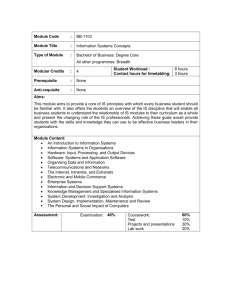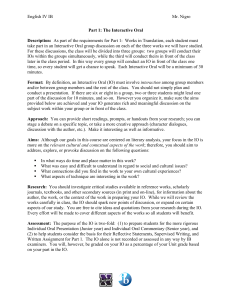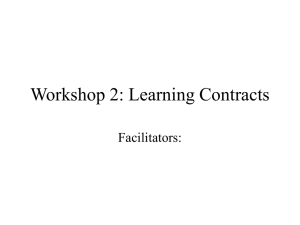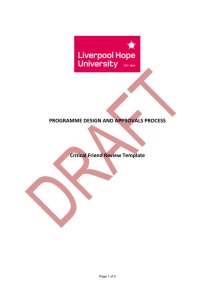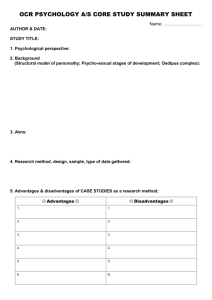The main aims of the guidance(1)
advertisement
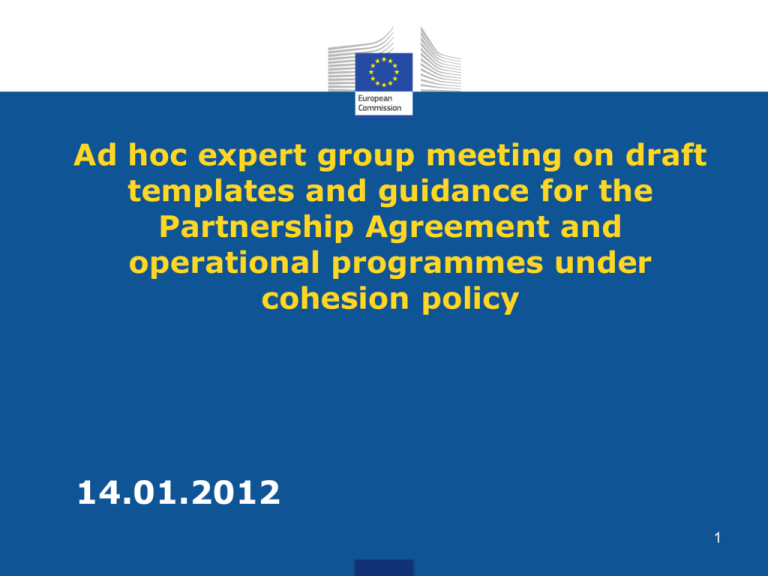
Ad hoc expert group meeting on draft templates and guidance for the Partnership Agreement and operational programmes under cohesion policy 14.01.2012 1 Documents (1) • • • • • The draft templates and guidance have been circulated ahead of the meeting Two elements: 1) template (structure), 2) guidance on the presentation of the content The aim of these documents is to: • ensure that there is a common understanding between the COM and the Member State on the expectations towards the content of the programming documents consistent approach • facilitate informal dialogue between the COM and the Member States These documents are provisional and are presented without prejudice to the on-going negotiations - "nothing is agreed until everything is agreed" Other guidance is under preparation e.g. on the intervention logic, ex-ante conditionalities, the performance framework, ex-2 ante evaluation etc. Documents (2) • The headings of the templates translate legal requirements on the content for the PA and the OP (Articles 14, 24 and 87 of the CPR) into a standard structure • The boxes provide guidance on the content of each of the sections • These documents do not constitute draft implementing acts • The implementing act for the model of the OP will be a technical document setting out: • data input fields for the SFC2014; • the form of data in each field; • character limits for each field. • The content of "guidance boxes" is nevertheless relevant as it helps to determine appropriate character limits to be set 3 out in the implementing act Aims of the meeting • The aim is to receive feedback from Member State experts on the draft documents to ensure that they are sufficiently clear, concise and take into account the diversity of programming and institutional arrangements in Member States • The legal framework set out within the CPR has been agreed - this is not subject to discussion • Therefore interventions should focus on: • identifying instances where the guidance elements proposed may need further clarification • proposals for better presentation of information incl. tables for quantitative data • The guidance will be adjusted following the expert meeting and made available. COM is open to another expert meeting, if needed 4 Discussion • One tour de table for the Partnership Agreement and one for the operational programme on cohesion policy • Interventions should focus on the main issues – other comments and proposals should be sent in writing until 18 January 5 The draft template and guidance on the Partnership Agreement Article 14 of the CPR 6 The role of the Partnership Agreement • • The PA constitutes a joint strategy at national level for the ESI Funds, which is consistent with the EU 2020 strategy and ensures that all ESI Funds are used towards jointly agreed objectives and in a complementary manner – this cannot be achieved at the level of programmes It should: • provide assurance for the Commission and for the partners/public, that the strategic choices are justified • promote cooperation and coordination between relevant authorities and upstream agreements on coordination arrangements to facilitate implementation later on • provide for transparency by including commitments not only vis a vis the Commission but also with respect to the partners and beneficiaries 7 Main blocks 1. Arrangements to ensure alignment with the Union strategy of smart, sustainable and inclusive growth as well as the Fund specific missions pursuant to their Treaty-based objectives, including economic, social and territorial cohesion (Article 14.1 (a) 2. Arrangements to ensure effective implementation (Article 14.1 (b)) 3. Description of the integrated approach to territorial development supported by the ESI Funds or a summary of the integrated approaches to territorial development based on the content of the programmes (article 14(2) (a)CPR) 4. Arrangements to ensure efficient implementation (Article 14.2 (b)) 8 1. Arrangements to ensure alignment with the Union strategy of smart, sustainable and inclusive growth as well as the Fund specific missions pursuant to their Treaty-based objectives, including economic, social and territorial cohesion (Article 14.1 (a)) 9 The main aims of the guidance(1) To ensure that the analysis of development needs in the Partnership Agreement: • is evidence based; • takes into account the EU 2020 objectives, targets and relevant country specific Council recommendations; • demonstrates consistency with the Common Strategic Framework; • takes into account sectoral challenges, territorial imbalances as well as cross-sectoral and cross -border challenges; • underpins the selection of the main funding priorities 10 and thematic objectives. The main aims of the guidance(2) To ensure that the Partnership Agreement demonstrates: • consistency of the strategic choices made i.e. the consistency between the development needs, funding priorities, thematic objectives, main results and the corresponding financial allocations; • that the observations of the ex-ante evaluators are duly considered and taken into account in a transparent manner in making these strategic choices and commitments; • implementation arrangements for horizontal principles and the fulfilment of the partnership principle. 11 2. Arrangements to ensure effective implementation (Article 14.1 (b)) 12 The main aims of the guidance(1) To ensure that the Partnership Agreement provides sufficient detail on: • coordination mechanisms at national (and regional) level put in place considering all relevant aspects, including possible complementarities, and practical possibilities (including those outlined in the CSF) • ex-ante conditionalities through information provided in a standard form and that there is sufficient information/supporting documentation to allow the assessment of the consistency of the information provided • the methodology for setting up of the performance framework and that assurance can be attained on a consistent approach across programmes 13 The main aims of the guidance(2) To ensure that: • the Member State presents a thorough analysis of the need to develop administrative capacity and the current burden of beneficiaries • the Member State commits to concrete actions at national level to improve capacity or reduce the burden of beneficiaries , where necessary, to improve the effectiveness of implementation – not only vis a vis the Commission, but also with regard to partners and beneficiaries 14 3. Description of the integrated approach to territorial development supported by the ESI Funds (Article 14(2) (a)CPR) 15 The main aims of the guidance(1) To ensure that: • the strategic choices presented reflect not only sectoral but also territorial considerations and that territorial needs and imbalances are considered and addressed in a coordinated manner, using all ESI Funds, as appropriate; • it is possible to assess whether the strategic choices made are consistent with relevant macro-regional strategies i.e. objectives jointly agreed for the macro-region, and that complementarities and the "division of tasks" with the ETC goal have been duly considered and exploited; • where instruments such as community-led local development and ITIs are used, which require a high degree of coordination and upstream cooperation between different authorities (especially where multiple ESI Funds are used), the Partnership Agreement sets out implementation arrangements and coordination structures agreed between relevant authorities. 16 The main aims of the guidance(2) To ensure that the Partnership Agreement sets out: • a methodical presentation of the situation in the Member State as regards poverty, and a clear and integrated approach to addressing poverty (note: EU2020 headline target), which includes the coordinated use of all relevant ESI Funds in a complementary manner to address the needs of areas most affected by poverty or groups in risk of exclusion; • the specific needs of areas which suffer from severe and permanent natural or demographic handicaps, and how these will be addressed. 17 4. Arrangements to ensure efficient implementation 18 The main aims of the guidance Main element: An assessment of the existing systems for electronic data exchange, and a summary of the actions planned to gradually achieve "e-cohesion policy" Aims of guidance: to ensure that the assessment takes account of the existing stage of development and that the Member State takes clear commitments as regards the steps needed to fulfil the legal requirement to establish systems for electronic exchange with beneficiaries – not only vis a vis the Commission but with respect to partners and beneficiaries 19 Thank you! Written comments can be sent until 18 January to: REGIO-DGA1.01-WORKSHOPS-ANDSEMINARS@ec.europa.eu 20 Operational programmes under cohesion policy Articles 24 and 87 of the CPR 21 Operational programme • The main role of the operational programme is to set out a coherent intervention strategy It should also: • Entail firm commitments as regards objectives, performance and funding • Take into account both sectoral challenges and territorial imbalances • Be consistent with the Partnership Agreement and complement it with a sectoral/regional perspective, but not repeat it • Be clear and concise 22 The main aims of the guidance • To facilitate the presentation of a coherent intervention logic throughout the operational programme by detailing the structure and content of the information • To clarify the links between the Partnership Agreement and the operational programme • To set out standard formats for data (financial table, indicators, ex-ante conditionalities etc.) to enable aggregation and/or simpler follow-up – input for the Implementing Act NB: Adaptation needed for ETC and technical assistance OPs 23 The strategy, the description of the priority axes and the financial plan 24 The main aims of the guidance • The main aim of the guidance is to provide a structure that facilitates the presentation of a coherent intervention strategy • The template provides for the main content elements - other guidance is under preparation on the elaboration of the intervention strategy, the performance framework, the assessment of the fulfilment of ex-ante conditionalities, the tools for territorial development etc. 25 The integrated approach to territorial development, poverty and to regions with permanent natural and demographic handicaps 26 The main aims of the guidance To ensure that the OP demonstrates that: • the integrated approaches outlined in the Partnership Agreement are supported by individual operational programmes • national authorities have agreed clear arrangements for the implementation of territorial approaches and the use of territorial development tools 27 Authorities responsible, the role of partners and coordination 28 The main aims of the guidance • To provide a standard structure for the information on authorities responsible for management, control and audit • To ensure that the national and programme authorities have set out clear arrangements and mechanisms for coordination of specific types of actions undertaken within operations and that they have analysed and harnessed complementarities between different instruments 29 Ex-ante conditionalities 30 The main aims of the guidance • To explain the link to the corresponding section of the Partnership Agreement – all ex-ante conditionalities applicable to the operational Programmes should be included • To provide a standard format for the presentation of the assessment of fulfilment of applicable exante conditionalities and for action plans, where applicable 31 Horizontal principles 32 The main aims of the guidance • To provide more guidance on how these principles should be integrated into operational programmes and which analysis should underpin decisions in this regard • To ensure that Member States have considered the possibilities for the integration of horizontal principles in their operational programmes, including the possibilities for mainstreaming 33 Annexes • List of major projects – should ensure that the national and programme authorities have a realistic forward planning for the largest operations (the list is subject to the "light" modification procedure) • The performance framework for the programme – an overview table, generated automatically on the basis on information entered for each priority axes 34 Thank you! Written comments can be sent until 18 January to: REGIO-DGA1.01-WORKSHOPS-ANDSEMINARS@ec.europa.eu 35

